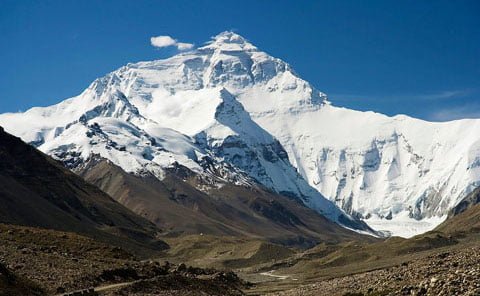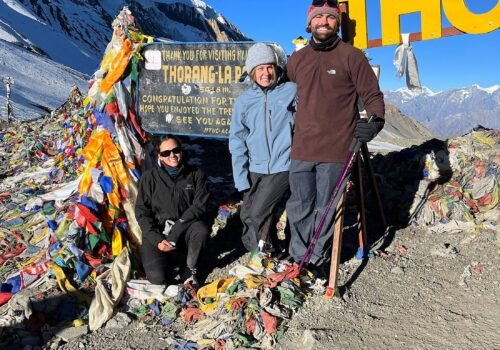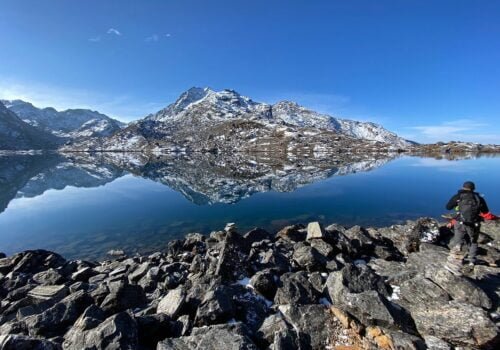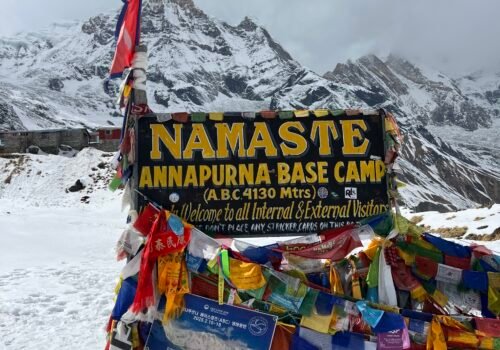A Complete Guide to Everest Base Camp Trek via Jiri
22 May 2025 8 min to read
Outdoor Himalayan presents ‘A Complete Guide to Everest Base Camp Trek via Jiri’ for easy planning and useful insights. Jiri is a beautiful village, the classic gateway to the Everest adventure. It is the same route followed by the first Everest summiteers, Edmund Hillary and Tenzing Norgay. The Jiri to Everest Base Camp route is long but rewarding, as it offers the region’s authenticity. The peaceful trails and rawness make it an ideal alternative route for new adventure seekers.
The trek route traverses through several beautiful villages, providing a rural lifestyle and cultural insights. Not only villages, but it passes through varied landscapes in the vicinity of towering snow-capped peaks. Witness pristine nature, diverse flora, and fauna in the Sagarmatha National Park, and several Buddhist monasteries. Reaching the Everest Base Camp feels victorious. The close-up panoramic views of Everest, Lhotse, Pumori, etc., enhance the region’s beauty as well as the trek experience.
Why Choose the Everest Base Camp Trek via Jiri?
Rural Life: The simple rural life, along with well-preserved culture, gives a glimpse into the Himalayan living style of the locals.
Pristine nature: The Jiri region route’s pristine nature offers a new adventurous experience along with peaceful trails.
Bucket-list Trek: Everest Base Camp is a bucket-list trek for several trek enthusiasts. Reaching this iconic base camp trek provides a sense of victory as well as motivation to trek.
Ecological Diversity: The trek from Jiri to the base camp teases trekkers with an unbelievable ecological and environmental diversity. It passes from subtropical to high alpine regions.
Buddhist Monasteries: Traverse through several Buddhist monasteries, and visit the region’s largest Tengboche Monastery and the oldest Pangboche Monastery.
Astonishing Mountain Views: The astonishing mountain views throughout the trek are captivating. The panoramic close-up views of Everest, Lhotse, Nuptse, Makalu, etc., intensify the excitement.
Ideal Mountain Adventure: An ideal mountain adventure filled with high-altitude challenges, yet rewarding.
Key Information at a Glance
Maximum Elevation: 5644.5m (Kalapatthar)
Physical Grading: Moderate
Best Seasons: Spring (March-May) & Autumn (September-November)
Accommodation: Basic teahouses along the trail
Meals: Full board during the trek (healthy, hygienic meals)
Permits Required: Sagarmatha National Park, Khumbu Pasang Lhamu Rural Municipality, and Trekkers Information Management System (TIMS)
Trek Route:
Sete – Junbesi – Nunthala – Bupsa – Paiya –Phakding – Namche Bazaar – Tengboche – Dingboche – Lobuche – Gorakshep – Everest Base Camp – Gorakshep – Kalapatthar – Pheriche – Namche Bazaar – Lukla
Also Read: Complete Guide to the Gokyo Ri Trek

Day-to-Day Short Overview
Day 01: Kathmandu arrival (1400 m)
Arrive in Kathmandu, get welcomed by the representative, and transfer to the hotel.
Day 02: Trek preparation day (Optional- Kathmandu city tour)
Documentation works (Issue of Permits, Paperworks), (Optional: Kathmandu city tour).
Day 03: Kathmandu to Bhandara (2250m), drive by public bus or a private jeep
A public bus drive to Bhandara takes 10 hours, while a private jeep ride takes 8 hours.
Day 04: Trek to Sete (2520 m)
Start trekking to Sete with a guide and porters.
Day 05: Trek to Junbesi (2700 m) via Lamjura pass (3530 m)
Traverse Lamjura Pass to reach Junbesi.
Day 06: Trek to Nunthala (2194 m)
Cross beautiful settlements to reach Nunthala.
Day 07: Trek to Bupsa (2430 m)
Cross a suspension bridge and ascend to Bupsa.
Day 08: Trek to Paiya (2730 m)
Admiring the mountain views, arrive at Paiya.
Day 09: Trek to Phakding (2610 m)
Walk on a comfortable plain trail to arrive at Phakding.
Day 10: Trek to Namche Bazaar (3440 m)
Trek to the vibrant Sherpa capital, Namche Bazaar, which is the gateway to the Everest Base Camp.
Day 11: Acclimatization day
Spend the first acclimatization day hiking to the Everest View Hotel or Khumjung Village (3,790 m).
Day 12: Trek to Tengboche (3867 m)
Trek to Tengboche, which is home to the largest Tengboche Monastery in the Everest region.
Day 13: Trek to Dingboche (4410 m)
Trek to only barley-grown place Dingboche, where you experience an increase in altitude, so trek slowly.
Day 14: Acclimatization day in Dingboche
Spend the second acclimatization day hiking to the grand Nangsar Tshang Peak (5,083 m) or the beautiful Chhukung Valley.
Day 15: Trek to Lobuche (4940 m)
Trek pass Khumbu Glacier moraine to reach Lobuche.
Day 16: Trek to Everest Base Camp (5364 m) via Gorakshep (5164 m) & back to Gorakshep
Adventurous trek to reach the iconic Everest Base Camp and return.
Day 17: Trek to Kalapatthar (5644.5 m) via Gorakshep, and trek back to Pheriche (4371 m)
Trek to the vantage point Kalapatthar for a close-up of Everest and other peaks views, and return to Pheriche.
Day 18: Trek to Tengboche (3867 m)
Return to Tengboche, which takes about 5 hours.
Day 19: Trek to Lukla (2610 m)
Return to Lukla takes about 7-8 hours.
Day 20: Fly to Kathmandu (1400 m)
Fly to Kathmandu and transfer to the hotel.
Day 21: Final Departure
Transfer to the airport for your departure.
Suggested: Everest Base Camp Trek via Salleri

Accommodation and Meals
Teahouses are accommodation means with basic but comfortable services, including healthy and hygienic meals. Food options include local Nepali dishes along with Indian and continental. The washrooms are mostly outside the teahouse as the elevation rises. There are options of boiled water or Mineral water bottles costing USD 1-2 for drinking.
Preparation and Fitness
The Everest Base Camp trek via Jiri is longer than the usual Base Camp trek. The trekking trails are rough, consisting of several ascents and descents. Hence, the trek is demanding and requires trekkers to be both physically and mentally fit. The trek is moderate, but trekkers must have a good fitness level to walk daily for long hours. To prepare for the trek, we suggest participating in exercises focusing on hiking and endurance. Also, maintain good health and consume healthy foods. Previous trek experience is a bonus. We highly suggest taking acclimatization rest and following the trek guidelines as scheduled.
Gear and Packing List
Warm clothing: Insulating layers, down jackets, trekking pants, thermals
Trekking boots: Durable, waterproof boots
Sleeping bag: Suitable for temperatures as low as (-10°C)
Accessories: Sunglasses, sunscreen, hats, trekking poles, headlamps, and a water purification system
Permits and Fees
The Everest Base Camp trek via Jiri requires three compulsory permits.
Khumbu Rural Municipality Permit
Foreigners- NPR 3000
SAARC- NPR 2000
Sagarmatha National Park (SNP)
Foreigners- NPR 3000
SAARC- NPR 1500
Trekkers Information Management System (TIMS)
Foreigners- NPR 2000/person
SAARC- NPR 1000/person
Diplomats/Foreign Officials & their families- NPR 500/person
Best Seasons to Trek
Autumn (September to November) and Spring (March to May) are the best seasons for the Everest Base Camp trek via Jiri. Favorable weather, moderate temperatures, blossoming seasonal flowers in Spring, comfortable walking trails, and vibrant scenery make these seasons ideal for trekking.
Winter (December to February) and Monsoon (June to August) seasons are generally not recommended for trekking. The unpredictable weather and slippery trails with unclear views make trekking in these seasons unpleasant. However, with proper planning and preparation, it is possible to trek in the Winter and Monsoon.
Also Read: 8 Different Everest Base Camp Trek Routes
Conclusion
The Everest Base Camp Trek via Jiri offers a vast experience, taking you through diverse landscapes and an absurd ecological and environmental diversity. Immersing in the local Sherpa culture and lifestyle, visiting Buddhist Monasteries, and walking in the vicinity of the snow-covered highest peaks, and the unspoiled beauty of the region make this trek a memorable one. A Complete Guide to Everest Base Camp Trek via Jiri is designed for the right planning and preparation, and we ensure it will prove beneficial.
Everest Base Camp Trek via Jiri Frequently Asked Questions
How long is the Everest Base Camp Trek via Jiri?
The Everest Base Camp trek via Jiri takes around 18 to 20 days to complete.
Do I need a guide for the Everest Base Camp Trek via Jiri?
A licensed guide is mandatory, and it is highly recommended for the Everest Base Camp Trek via Jiri.
Can I do the Everest Base Camp Trek via Jiri independently?
Independent Everest Base Camp Trek via Jiri is strictly prohibited.
Are there any age restrictions for the Everest Base Camp Trek via Jiri?
There are no age restrictions, but we still recommend parental guidance for children below 16.
Are there any alternative routes or side trips on the Everest Base Camp Trek via Jiri?
Some popular side trips on the Everest Base Camp Trek via Jiri are Khumjung Village and Gokyo Lake.
Are there ATM facilities available along the Everest Base Camp Trek via Jiri?
There are ATM facilities at Namche Bazaar on the Everest Base Camp Trek via Jiri route. We highly suggest carrying enough cash (in Nepalese rupees) to cover your expenses throughout the trek.
Are there any communication facilities available during the Everest Base Camp Trek via Jiri?
There are limited communication facilities, such as mobile network coverage and Wi-Fi, along the Everest Base Camp Trek via Jiri.
Can I extend or customize the Everest Base Camp Trek via Jiri?
Yes, the Everest Base Camp Trek via Jiri can be extended or customized, and consult with a trekking agency for it.





